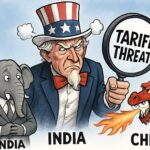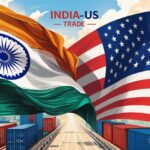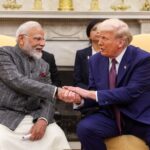Brendan Lynch, assistant US Trade Representative (USTR) for South and Central Asia, lands in New Delhi on the night of September 15, 2025, for a one-day visit that officials insist is “not a round of negotiations.”
Yet, his presence underscores the precarious state of India–US trade talks, stalled by Washington’s tariff onslaught and New Delhi’s refusal to bend on Russian oil imports and farm sector protection.
Special Secretary Rajesh Agrawal was at pains to downplay the trip, describing it as a “discussion” limited to trade matters. But the fact that the sixth round of formal talks, due last month in Delhi, was postponed after US President Donald Trump doubled tariffs on Indian goods to 50 percent, gives Lynch’s stopover unusual weight.
The question now is whether India can navigate an increasingly untenable position — keeping strategic oil imports from Moscow flowing, sheltering politically sensitive farm and dairy markets, and still convincing Washington it wants a deal.
Tariffs Bite, Trade Talks Stumble
India’s exports for August stood at $35.10 billion while imports hit $61.59 billion, leaving a sizeable deficit. Officials are quick to highlight that the gap has narrowed. But the numbers mask a harsher reality: exporters in textiles, gems and jewelry, and leather — precisely the labor-intensive sectors that absorb millions of low-wage workers — are now directly exposed to Trump’s tariffs. Unlike large-scale manufacturers, these sectors lack pricing power and cannot quickly diversify to alternative markets.
Trump’s tariffs, justified on “reciprocity” grounds and linked explicitly to India’s Russian oil purchases, are designed to squeeze New Delhi politically as well as commercially. Washington’s message is clear: trade benefits will not be extended without strategic concessions. India’s claim that exports are “holding up” rings hollow when its peers, Vietnam and Bangladesh, now enjoy a competitive edge in the same categories in the US market.
Lynch’s Limited Leverage
Lynch, a seasoned negotiator who has previously overseen US agricultural trade pushes, arrives with little room to maneuver. For Washington, agriculture and dairy access remain red lines; for India, they are immovable walls. Politically, no government in New Delhi can afford to expose millions of small farmers to subsidized US agribusiness imports. This deadlock is not new — it was one reason India walked away from the Regional Comprehensive Economic Partnership (RCEP) in 2019.
The US side knows this but is betting that India’s desire for tariff relief will force compromises elsewhere, perhaps in intellectual property, e-commerce, or digital trade rules. For India, conceding in those areas could mean giving up space in future growth sectors — a risk the government may not publicly admit, but one it cannot ignore.
Political Optics vs Economic Realities
The diplomatic theatre around Lynch’s visit is carefully choreographed. Trump has called Modi a “dear friend,” Modi has returned the sentiment, and both sides publicly stress the “natural partnership.” Finance Minister Nirmala Sitharaman insists Indian negotiators are “deeply engaged.” Yet these optics obscure the core contradiction: India wants preferential market access in the US without making reciprocal concessions, while Trump has made tariff reciprocity his signature.
Even if an interim trade deal is clinched by the self-imposed October–November deadline, it is unlikely to address the structural gulf on agriculture or tariffs. At best, it may deliver cosmetic wins — modest tariff reductions or greater access for niche goods — while leaving larger issues unresolved. That would buy time politically but not shield Indian exporters from the current squeeze.
Domestic Constraints
India’s ability to offer concessions is further constrained by its domestic priorities. The government is preparing an Export Promotion Mission worth ₹25,000 crore (about $3 billion) to cushion exporters, but such subsidies are at best a stopgap. They do not solve the fundamental problem of Indian goods losing competitiveness in the US market due to punitive duties.
At the same time, New Delhi cannot abandon discounted Russian oil without risking a spike in domestic energy prices — politically dangerous in an election cycle. Nor can it open agriculture and dairy, which underpin rural livelihoods and food security. In effect, India has boxed itself in the very pillars of its domestic policy are the sticking points in negotiations with Washington.
A Narrowing Window
The real risk is that India miscalculates Washington’s patience. Trump has already escalated once, from 25 to 50 percent tariffs, and has signaled no hesitation in ratcheting further. If India waits for a political thaw without offering meaningful movement, it may find itself isolated, with key export sectors eroded and global supply chains shifting toward nimbler competitors.
Commerce Secretary Sunil Barthwal pointed to the upcoming EU talks in Brussels as a sign of diversification. But even that track record is mixed: India’s EU negotiations have dragged on for years, tripped up by the same sensitivities over agriculture, data protection, and investment. If India fails to resolve its contradictions with the US, it risks repeating the same stalemate in Europe.
The Test of Strategic Choices
Lynch’s visit, brief as it is, crystallizes a larger test. India cannot simultaneously shield its farmers, cling to Russian oil, resist digital and data demands, and still expect tariff-free access to the world’s largest economy. Something will eventually give — whether through deliberate choice or by Washington forcing the issue.
For now, the government is projecting confidence, banking on resilience in exports and diplomatic goodwill. But unless it reconciles its domestic compulsions with external demands, New Delhi’s balancing act may prove unsustainable, leaving its exporters to bear the brunt of a geopolitical standoff masquerading as a trade dispute.






